Birch Barbara M. English L2 Reading: Getting to the Bottom
Подождите немного. Документ загружается.

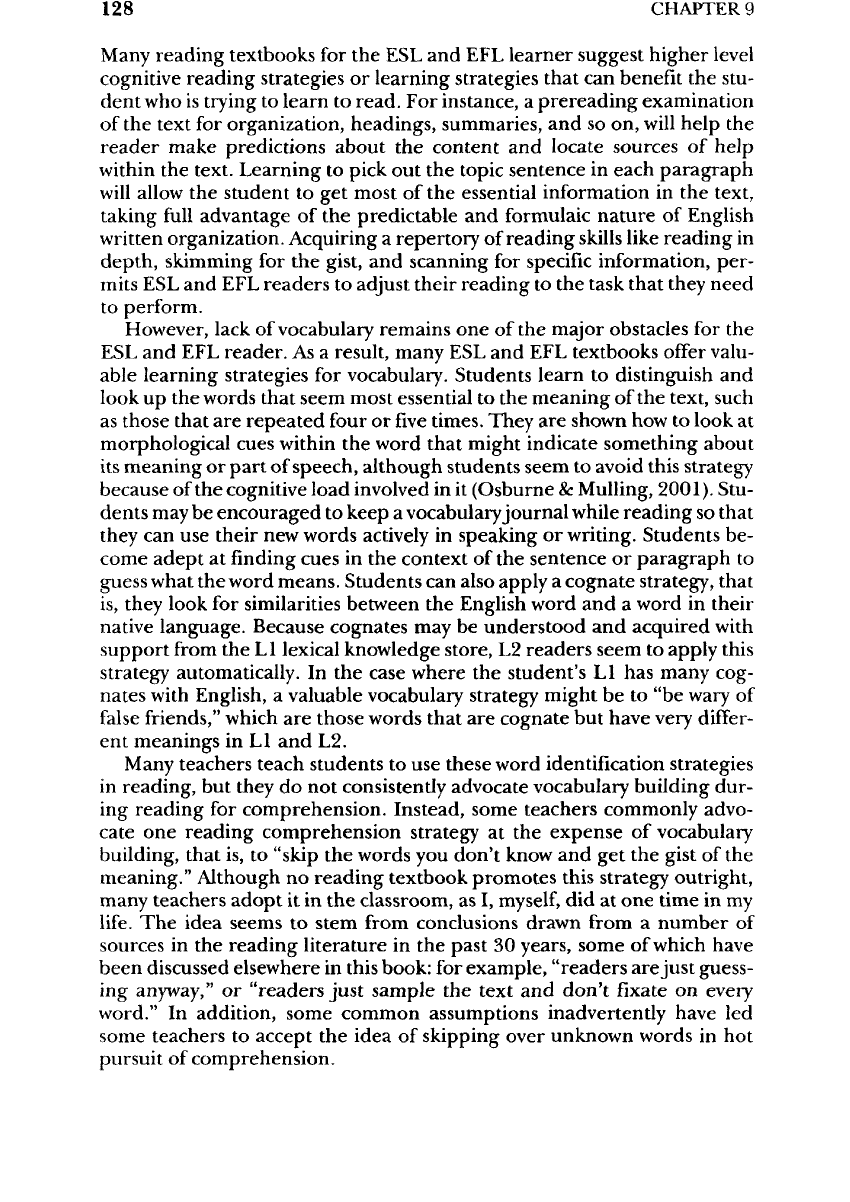
128
CHAPTER
9
Many
reading textbooks
for the ESL and EFL
learner suggest higher level
cognitive reading strategies
or
learning strategies that
can
benefit
the
stu-
dent
who is
trying
to
learn
to
read.
For
instance,
a
prereading
examination
of
the
text
for
organization, headings, summaries,
and so on,
will
help
the
reader
make predictions about
the
content
and
locate sources
of
help
within
the
text. Learning
to
pick
out the
topic sentence
in
each paragraph
will
allow
the
student
to get
most
of the
essential information
in the
text,
taking
full
advantage
of the
predictable
and
formulaic
nature
of
English
written
organization. Acquiring
a
repertory
of
reading
skills
like reading
in
depth, skimming
for the
gist,
and
scanning
for
specific information, per-
mits
ESL and EFL
readers
to
adjust
their reading
to the
task that they need
to
perform.
However,
lack
of
vocabulary remains
one of the
major obstacles
for the
ESL
and EFL
reader.
As a
result, many
ESL and EFL
textbooks
offer
valu-
able learning strategies
for
vocabulary. Students learn
to
distinguish
and
look
up the
words that seem most essential
to the
meaning
of the
text, such
as
those that
are
repeated four
or
five
times.
They
are
shown
how to
look
at
morphological cues within
the
word that might indicate something about
its
meaning
or
part
of
speech, although students seem
to
avoid this strategy
because
of the
cognitive load involved
in it
(Osburne
&
Mulling,
2001).
Stu-
dents
may be
encouraged
to
keep
a
vocabulary
journal
while reading
so
that
they
can use
their
new
words actively
in
speaking
or
writing. Students
be-
come
adept
at
finding cues
in the
context
of the
sentence
or
paragraph
to
guess
what
the
word
means.
Students
can
also apply
a
cognate strategy, that
is,
they look
for
similarities between
the
English word
and a
word
in
their
native
language. Because cognates
may be
understood
and
acquired with
support
from
the
LI
lexical knowledge store,
L2
readers seem
to
apply this
strategy
automatically.
In the
case where
the
student's
LI
has
many cog-
nates with English,
a
valuable vocabulary strategy might
be to "be
wary
of
false
friends," which
are
those words that
are
cognate
but
have very
differ-
ent
meanings
in
LI
and L2.
Many
teachers teach students
to use
these word identification strategies
in
reading,
but
they
do not
consistently advocate vocabulary building dur-
ing
reading
for
comprehension. Instead, some teachers commonly advo-
cate
one
reading comprehension strategy
at the
expense
of
vocabulary
building,
that
is, to
"skip
the
words
you
don't
know
and get the
gist
of the
meaning." Although
no
reading
textbook
promotes
this strategy outright,
many
teachers
adopt
it in the
classroom,
as I,
myself,
did at one
time
in my
life.
The
idea seems
to
stem
from
conclusions drawn
from
a
number
of
sources
in the
reading literature
in the
past
30
years, some
of
which have
been discussed elsewhere
in
this
book:
for
example,
"readers
are
just
guess-
ing
anyway,"
or
"readers
just sample
the
text
and
don't
fixate on
every
word."
In
addition, some common assumptions inadvertently have
led
some teachers
to
accept
the
idea
of
skipping over unknown words
in hot
pursuit
of
comprehension.

VOCABULARY
ACQUISITION
129
ASSUMPTION
1:
L2
READERS
CAN
COMPENSATE
FOR
LACK
OF
SPECIFIC
LANGUAGE
KNOWLEDGE
WITH
BACKGROUND
KNOWLEDGE
Coady,
1979,
said
the
following:
Since
the
various process strategies interact among themselves,
the ESL
stu-
dent should take advantage
of his
strengths
in
order
to
overcome
his
weak-
nesses.
For
example, greater background knowledge
of a
particular subject
could compensate somewhat
for a
lack
of
syntactic control
over
the
lan-
guage...
. The
proficient reader learns
to
utilize
whatever
cue
systems render
useful
information
and to put
them together
in a
creative
manner, always
achieving
at
least
some
comprehension.
This weakness
in one
area
can be
overcome
by a
strength
in
another,
(p.
11;
emphasis added)
ASSUMPTION
2:
READERS
DO NOT
NEED
TO
UNDERSTAND
EVERYTHING
IN THE
TEXT
FOR
ADEQUATE
COMPREHENSION
Clarke
and
Silberstein,
1979,
said
the
following:
Students must
be
made aware
of the
number
of
language clues available
to
them
when they
are
stopped
by an
unfamiliar word. They should realize that
they
can
usually continue reading
and
obtain
a
general understanding
of the
item....
Most importantly, they must
be
taught
to
recognize situations
in
which
the
meaning
of the
word
or
phrase
is not
essential
for
adequate
com-
prehension
of the
passage,
(p. 51)
Been,
1979,
said
the
following:
The
readers should
be
given cues which lead
him to
ignore linearity, help
him
to
exploit redundancies,
and
demonstrate
that
meaning
can be
apprehended
even
though
he
does
not
understand
every
word.
(p. 98)
Day
and
Bamford,
1998,
said
the
following:
Part
of
fluent
and
effective reading involves
the
reader
ignoring
unknown
words
and
phrases
or, if
understanding
them
is
essential,
guessing
their
ap-
proximate
meaning,
(p. 93)
ASSUMPTION
3:
VOCABULARY
INSTRUCTION
TAKES
UP
TOO
MUCH
TIME
IN THE
READING
CLASS
Gaskill,
1979,
said
the
following:
Many
instructors
ask
their students
to
learn vocabulary items which
are
found
in
their reading selections. This
can be
helpful
if the
number
of
words
is
held
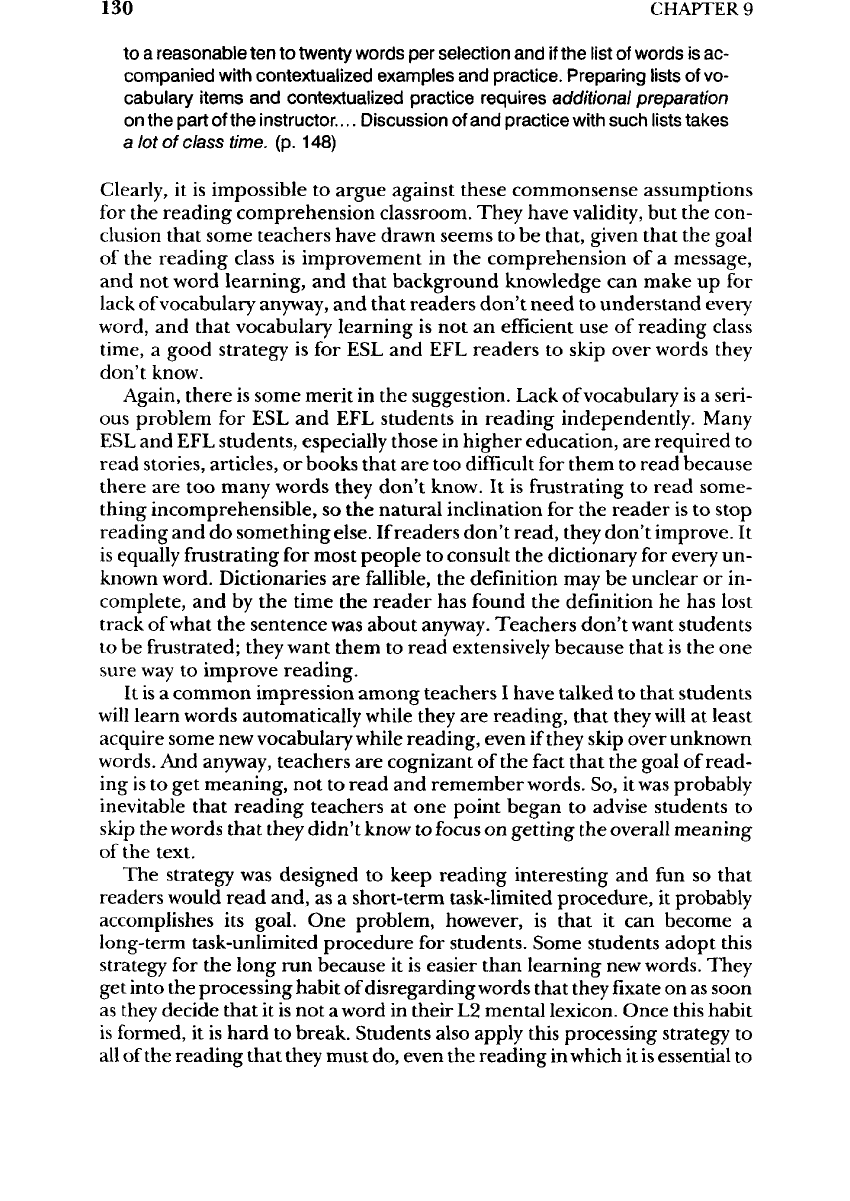
130
CHAPTER
9
to a
reasonable
ten to
twenty words
per
selection
and if the
list
of
words
is ac-
companied
with
contextualized
examples
and
practice. Preparing lists
of vo-
cabulary items
and
contextualized practice requires
additional
preparation
on
the
part
of the
instructor....
Discussion
of and
practice with such
lists
takes
a lot of
class
time.
(p.
148)
Clearly,
it is
impossible
to
argue against these commonsense assumptions
for
the
reading comprehension classroom. They have
validity,
but the
con-
clusion
that some teachers have drawn seems
to be
that, given that
the
goal
of
the
reading class
is
improvement
in the
comprehension
of a
message,
and not
word learning,
and
that background knowledge
can
make
up for
lack
of
vocabulary
anyway,
and
that readers don't need
to
understand every
word,
and
that vocabulary learning
is not an
efficient
use of
reading class
time,
a
good strategy
is for ESL and EFL
readers
to
skip over words they
don't know.
Again,
there
is
some merit
in the
suggestion. Lack
of
vocabulary
is a
seri-
ous
problem
for ESL and EFL
students
in
reading independently.
Many
ESL
and EFL
students, especially those
in
higher education,
are
required
to
read stories, articles,
or
books that
are too
difficult
for
them
to
read because
there
are too
many words they
don't
know.
It is
frustrating
to
read some-
thing
incomprehensible,
so the
natural inclination
for the
reader
is to
stop
reading
and do
something else.
If
readers don't read, they
don't
improve.
It
is
equally frustrating
for
most
people
to
consult
the
dictionary
for
every
un-
known
word. Dictionaries
are
fallible,
the
definition
may be
unclear
or in-
complete,
and by the
time
the
reader
has
found
the
definition
he has
lost
track
of
what
the
sentence
was
about
anyway.
Teachers
don't
want
students
to be
frustrated; they want them
to
read extensively because that
is the one
sure
way to
improve reading.
It
is a
common impression among teachers
I
have talked
to
that students
will
learn words automatically while they
are
reading, that they
will
at
least
acquire some
new
vocabulary while reading, even
if
they skip over unknown
words.
And
anyway,
teachers
are
cognizant
of the
fact
that
the
goal
of
read-
ing
is to get
meaning,
not to
read
and
remember words.
So, it was
probably
inevitable
that reading teachers
at one
point began
to
advise students
to
skip
the
words that they didn't know
to
focus
on
getting
the
overall meaning
of
the
text.
The
strategy
was
designed
to
keep reading interesting
and fun so
that
readers would
read
and,
as a
short-term task-limited
procedure,
it
probably
accomplishes
its
goal.
One
problem, however,
is
that
it can
become
a
long-term
task-unlimited procedure
for
students. Some students adopt this
strategy
for the
long
run
because
it is
easier than learning
new
words. They
get
into
the
processing habit
of
disregarding words that they
fixate on as
soon
as
they
decide that
it is not a
word
in
their
L2
mental lexicon. Once
this
habit
is
formed,
it is
hard
to
break. Students also apply this processing strategy
to
all
of the
reading that they must
do,
even
the
reading
in
which
it is
essential
to
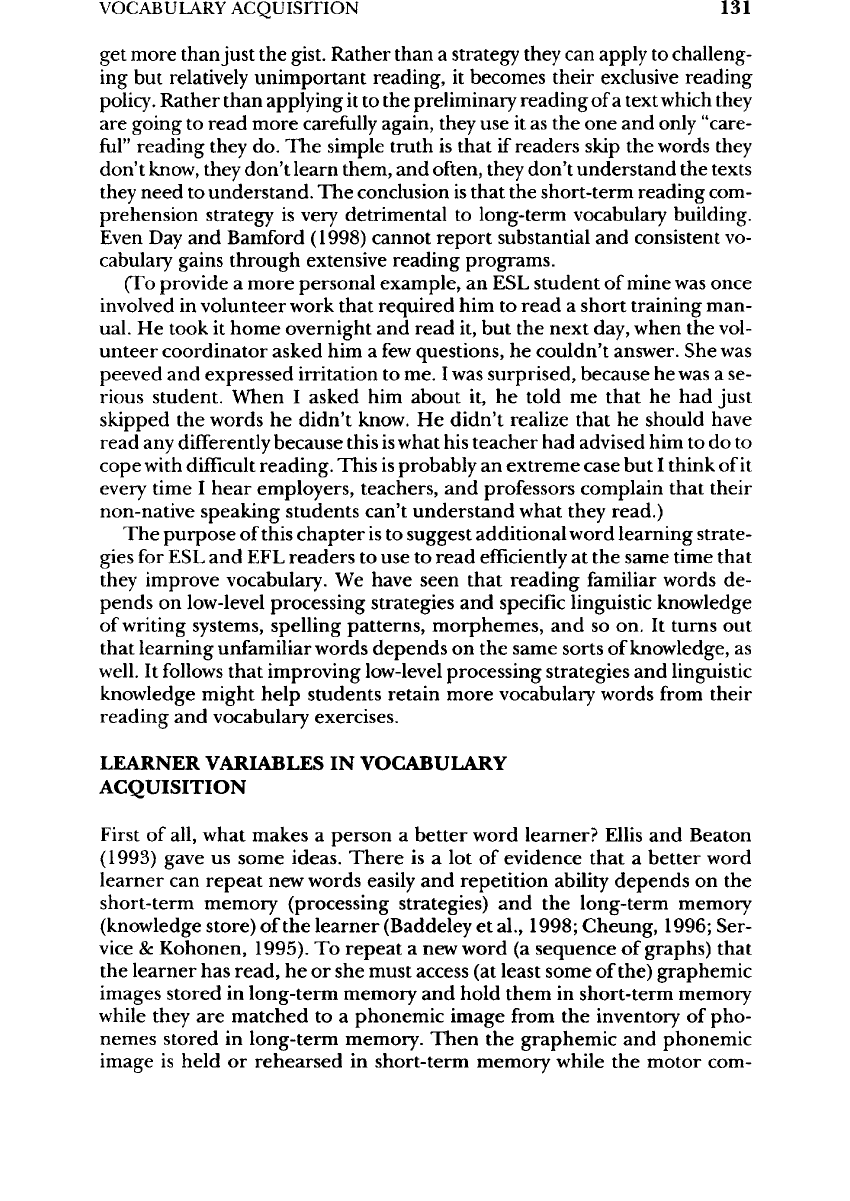
VOCABULARY
ACQUISITION
131
get
more than just
the
gist. Rather than
a
strategy they
can
apply
to
challeng-
ing
but
relatively unimportant reading,
it
becomes their exclusive reading
policy.
Rather than applying
it to the
preliminary reading
of a
text
which
they
are
going
to
read
more
carefully
again, they
use it as the one and
only "care-
ful"
reading they
do. The
simple truth
is
that
if
readers skip
the
words
they
don't
know,
they
don't
learn them,
and
often, they don't understand
the
texts
they
need
to
understand.
The
conclusion
is
that
the
short-term reading com-
prehension strategy
is
very
detrimental
to
long-term vocabulary building.
Even
Day and
Bamford
(1998)
cannot
report
substantial
and
consistent
vo-
cabulary
gains through extensive reading programs.
(To
provide
a
more personal example,
an ESL
student
of
mine
was
once
involved
in
volunteer work that
required
him to
read
a
short training man-
ual.
He
took
it
home overnight
and
read
it, but the
next day, when
the
vol-
unteer coordinator asked
him a
few
questions,
he
couldn't answer.
She was
peeved
and
expressed irritation
to me. I was
surprised, because
he was a se-
rious
student. When
I
asked
him
about
it, he
told
me
that
he had
just
skipped
the
words
he
didn't know.
He
didn't realize that
he
should have
read
any
differently
because this
is
what
his
teacher
had
advised
him to do to
cope
with
difficult
reading.
This
is
probably
an
extreme case
but I
think
of it
every
time
I
hear employers, teachers,
and
professors complain that their
non-native
speaking students can't understand what they read.)
The
purpose
of
this chapter
is to
suggest additional word learning strate-
gies
for ESL and EFL
readers
to use to
read
efficiently
at the
same time that
they
improve vocabulary.
We
have seen that reading
familiar
words
de-
pends
on
low-level processing strategies
and
specific linguistic knowledge
of
writing
systems, spelling patterns, morphemes,
and so on. It
turns
out
that
learning
unfamiliar
words depends
on the
same sorts
of
knowledge,
as
well.
It
follows
that improving low-level processing strategies
and
linguistic
knowledge
might help students retain more vocabulary words
from
their
reading
and
vocabulary exercises.
LEARNER
VARIABLES
IN
VOCABULARY
ACQUISITION
First
of
all, what makes
a
person
a
better word learner?
Ellis
and
Beaton
(1993)
gave
us
some ideas.
There
is a lot of
evidence that
a
better word
learner
can
repeat
new
words easily
and
repetition ability depends
on the
short-term memory (processing strategies)
and the
long-term memory
(knowledge
store)
of the
learner
(Baddeley
et
al.,
1998; Cheung, 1996; Ser-
vice
&
Kohonen, 1995).
To
repeat
a new
word
(a
sequence
of
graphs) that
the
learner
has
read,
he or she
must access
(at
least some
of
the)
graphemic
images
stored
in
long-term memory
and
hold them
in
short-term memory
while
they
are
matched
to a
phonemic image
from
the
inventory
of
pho-
nemes
stored
in
long-term memory.
Then
the
graphemic
and
phonemic
image
is
held
or
rehearsed
in
short-term memory while
the
motor com-
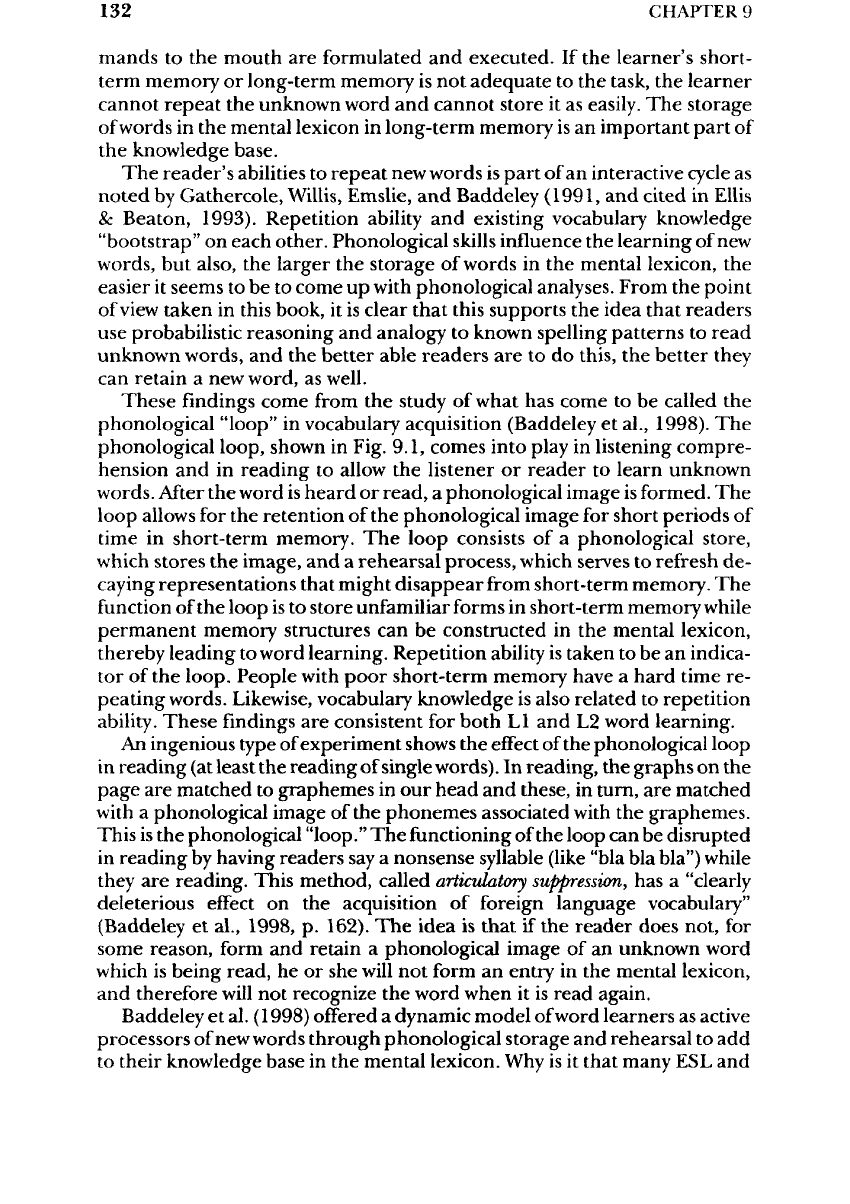
132
CHAPTER
9
mands
to the
mouth
are
formulated
and
executed.
If the
learner's short-
term memory
or
long-term memory
is not
adequate
to the
task,
the
learner
cannot repeat
the
unknown word
and
cannot store
it as
easily.
The
storage
of
words
in the
mental lexicon
in
long-term memory
is an
important part
of
the
knowledge base.
The
reader's abilities
to
repeat
new
words
is
part
of an
interactive cycle
as
noted
by
Gathercole,
Willis,
Emslie,
and
Baddeley
(1991,
and
cited
in
Ellis
&
Beaton, 1993). Repetition ability
and
existing vocabulary knowledge
"bootstrap"
on
each other. Phonological skills influence
the
learning
of new
words,
but
also,
the
larger
the
storage
of
words
in the
mental lexicon,
the
easier
it
seems
to be to
come
up
with phonological analyses. From
the
point
of
view
taken
in
this book,
it is
clear that this supports
the
idea that readers
use
probabilistic reasoning
and
analogy
to
known spelling patterns
to
read
unknown words,
and the
better
able
readers
are to do
this,
the
better
they
can
retain
a new
word,
as
well.
These
findings
come from
the
study
of
what
has
come
to be
called
the
phonological "loop"
in
vocabulary acquisition (Baddeley
et
al.,
1998).
The
phonological loop, shown
in
Fig.
9.1,
comes into play
in
listening compre-
hension
and in
reading
to
allow
the
listener
or
reader
to
learn unknown
words.
After
the
word
is
heard
or
read,
a
phonological image
is
formed.
The
loop
allows
for the
retention
of the
phonological
image
for
short
periods
of
time
in
short-term memory.
The
loop consists
of a
phonological store,
which
stores
the
image,
and a
rehearsal process, which serves
to
refresh
de-
caying
representations that might disappear from short-term
memory.
The
function
of the
loop
is to
store unfamiliar forms
in
short-term memory while
permanent memory structures
can be
constructed
in the
mental lexicon,
thereby leading
to
word learning. Repetition ability
is
taken
to be an
indica-
tor of the
loop.
People
with
poor
short-term
memory have
a
hard
time
re-
peating words. Likewise, vocabulary knowledge
is
also related
to
repetition
ability.
These
findings
are
consistent
for
both
LI
and L2
word learning.
An
ingenious type
of
experiment shows
the
effect
of the
phonological loop
in
reading
(at
least
the
reading
of
single words).
In
reading,
the
graphs
on the
page
are
matched
to
graphemes
in our
head
and
these,
in
turn,
are
matched
with
a
phonological image
of the
phonemes associated
with
the
graphemes.
This
is the
phonological
"loop."
The
functioning
of the
loop
can be
disrupted
in
reading
by
having readers
say a
nonsense syllable (like
"bla
bla
bla")
while
they
are
reading. This method, called
articulatory
suppression,
has a
"clearly
deleterious
effect
on the
acquisition
of
foreign language vocabulary"
(Baddeley
et
al.,
1998,
p.
162).
The
idea
is
that
if the
reader
does
not,
for
some
reason,
form
and
retain
a
phonological image
of an
unknown word
which
is
being read,
he or she
will
not
form
an
entry
in the
mental lexicon,
and
therefore
will
not
recognize
the
word when
it is
read again.
Baddeley
et al.
(1998)
offered
a
dynamic model
of
word
learners
as
active
processors
of
new
words through phonological storage
and
rehearsal
to add
to
their knowledge base
in the
mental lexicon.
Why is it
that many
ESL and
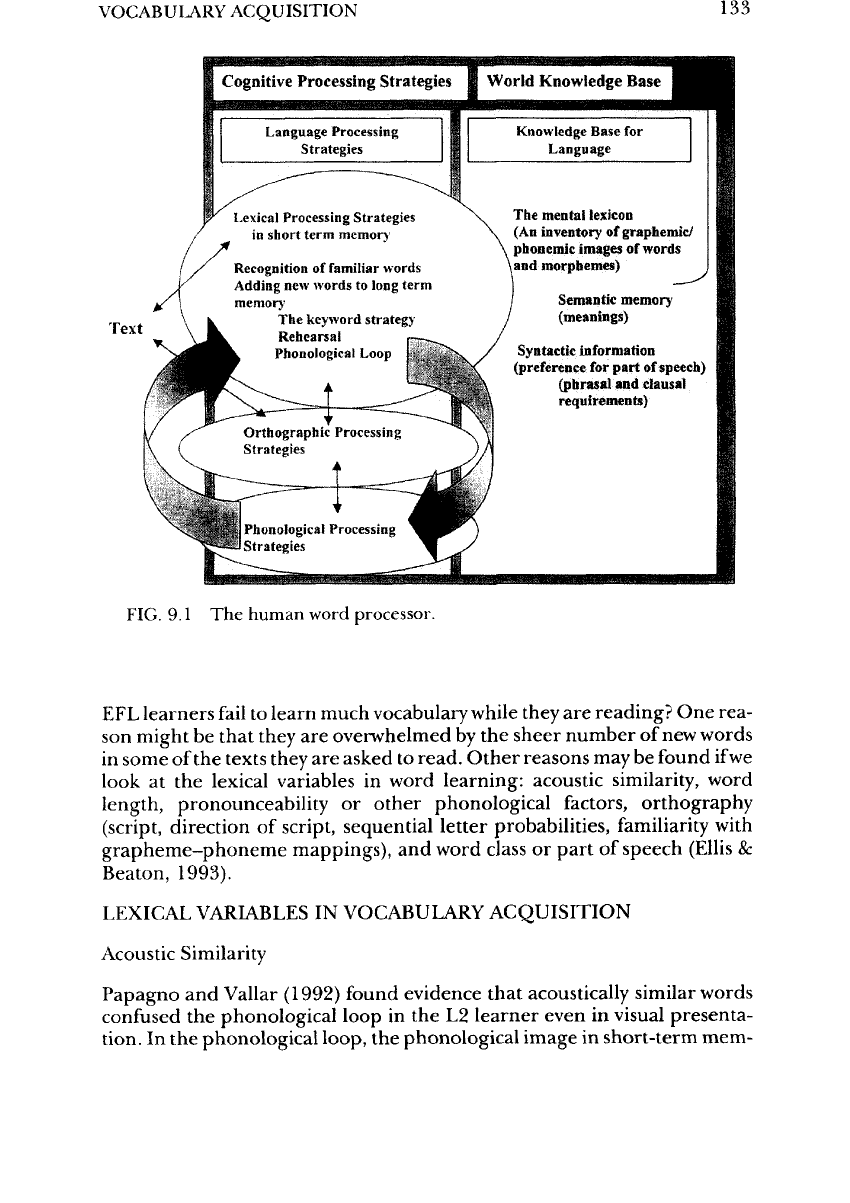
VOCABULARY
ACQUISITION
133
Text
Cognitive
Processing
Strategies
World
Knowledge Base
Knowledge Base
for
Language
Language Processing
Strategies
The
mental lexicon
(An
inventory
of
graphemic/
phonemic images
of
words
and
morphemes)
Lexical
Processing Strategies
in
short
term
memory
Recognition
of
familiar
words
Adding
new
words
to
long
term
memory
The
keyword strategy
Rehearsal
Phonological
Loop
Semantic memory
(meanings)
Syntactic information
(preference
for
part
of
speech)
(phrasal
and
clausal
requirements)
Orthographic
Processing
Strategies
Phonological
Processing
Strategies
FIG.
9.1
The
human word processor.
EFL
learners
fail
to
learn much vocabulary while they
are
reading?
One
rea-
son
might
be
that they
are
overwhelmed
by the
sheer
number
of new
words
in
some
of the
texts they
are
asked
to
read.
Other
reasons
may be
found
if
we
look
at the
lexical variables
in
word learning: acoustic similarity, word
length, pronounceability
or
other phonological factors, orthography
(script,
direction
of
script, sequential letter probabilities, familiarity with
grapheme-phoneme
mappings),
and
word class
or
part
of
speech
(Ellis
&
Beaton, 1993).
LEXICAL
VARIABLES
IN
VOCABULARY ACQUISITION
Acoustic
Similarity
Papagno
and
Vallar (1992) found evidence that acoustically similar words
confused
the
phonological loop
in the L2
learner
even
in
visual presenta-
tion.
In the
phonological
loop,
the
phonological
image
in
short-term
mem-
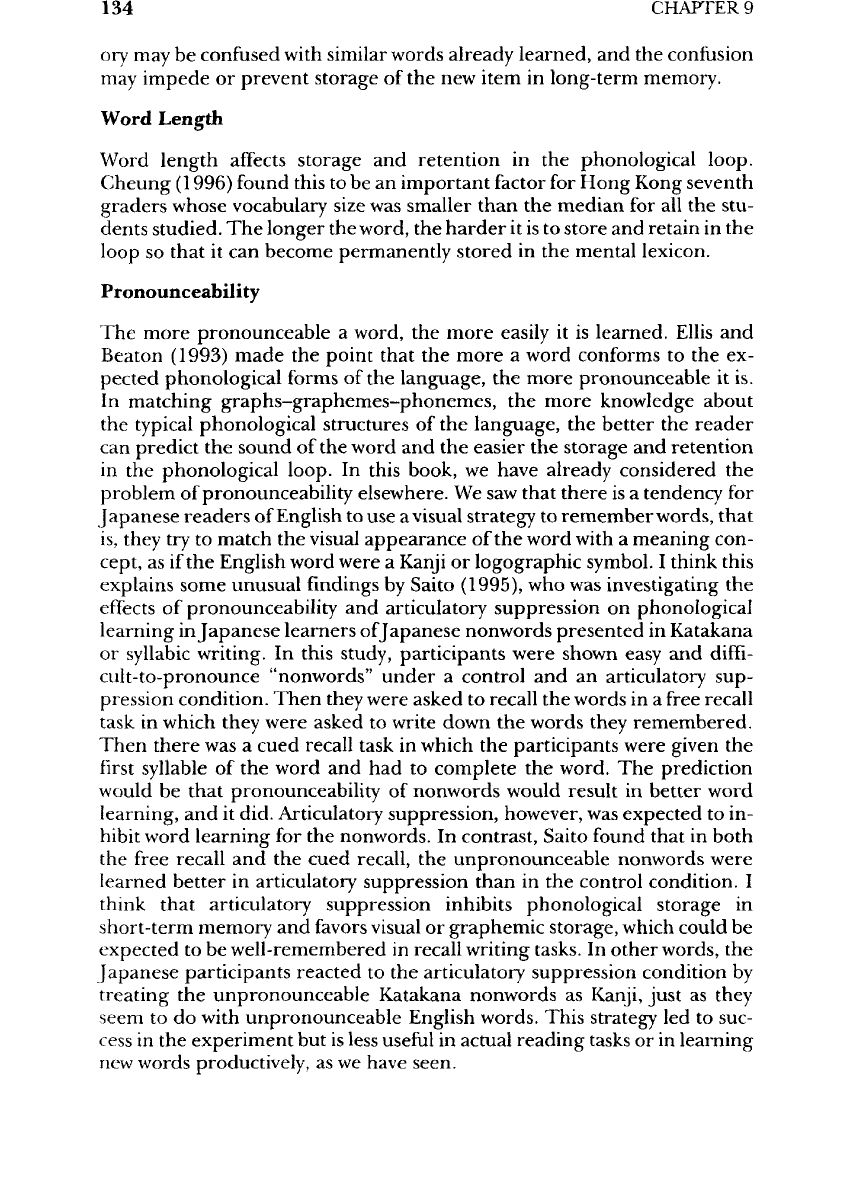
134
CHAFFER
9
ory
may be
confused
with
similar words already learned,
and the
confusion
may
impede
or
prevent storage
of the new
item
in
long-term memory.
Word
Length
Word
length
affects
storage
and
retention
in the
phonological loop.
Cheung
(1996)
found this
to be an
important
factor
for
Hong Kong seventh
graders whose vocabulary
size
was
smaller than
the
median
for all the
stu-
dents studied.
The
longer
the
word,
the
harder
it is to
store
and
retain
in the
loop
so
that
it can
become permanently stored
in the
mental lexicon.
Pronounceability
The
more pronounceable
a
word,
the
more
easily
it is
learned.
Ellis
and
Beaton
(1993)
made
the
point that
the
more
a
word conforms
to the ex-
pected phonological forms
of the
language,
the
more pronounceable
it is.
In
matching
graphs-graphemes-phonemes,
the
more knowledge about
the
typical
phonological structures
of the
language,
the
better
the
reader
can
predict
the
sound
of the
word
and the
easier
the
storage
and
retention
in
the
phonological loop.
In
this book,
we
have already considered
the
problem
of
pronounceability
elsewhere.
We saw
that there
is a
tendency
for
Japanese
readers
of
English
to use a
visual strategy
to
remember words, that
is,
they
try to
match
the
visual
appearance
of the
word
with
a
meaning con-
cept,
as if the
English word were
a
Kanji
or
logographic
symbol.
I
think this
explains some unusual
findings
by
Saito
(1995),
who was
investigating
the
effects
of
pronounceability
and
articulatory
suppression
on
phonological
learning
in
Japanese
learners
of
Japanese nonwords presented
in
Katakana
or
syllabic
writing.
In
this study, participants were shown
easy
and
diffi-
cult-to-pronounce
"nonwords" under
a
control
and an
articulatory sup-
pression
condition.
Then
they were asked
to
recall
the
words
in a
free
recall
task
in
which they were asked
to
write down
the
words they remembered.
Then
there
was a
cued recall
task
in
which
the
participants were given
the
first
syllable
of the
word
and had to
complete
the
word.
The
prediction
would
be
that pronounceability
of
nonwords would result
in
better word
learning,
and it
did. Articulatory suppression, however,
was
expected
to in-
hibit
word
learning
for the
nonwords.
In
contrast,
Saito found that
in
both
the
free
recall
and the
cued recall,
the
unpronounceable nonwords were
learned better
in
articulatory suppression than
in the
control condition.
I
think
that articulatory suppression inhibits phonological storage
in
short-term
memory
and
favors
visual
or
graphemic
storage, which could
be
expected
to be
well-remembered
in
recall writing
tasks.
In
other words,
the
Japanese participants reacted
to the
articulatory suppression condition
by
treating
the
unpronounceable Katakana nonwords
as
Kanji,
just
as
they
seem
to do
with unpronounceable English words. This strategy
led to
suc-
cess
in the
experiment
but is
less
useful
in
actual reading
tasks
or in
learning
new
words productively,
as we
have
seen.

VOCABULARY
ACQUISITION
135
Orthography
In
Ellis
and
Beaton's
(1993)
study
of
English
learners
who
knew
no
German,
the
degree
to
which
the
German word conformed
to the
orthographic pat-
terns
of
English
affected
their ability
to
translate
from
English
to
German.
It
is
obvious that these
individuals
who
knew
no
German
had no
knowledge
of
German
letter-to-sound
patterns
and
could only learn words based
on
their
similarity
to
English.
This
study
does, however, reinforce
the
idea that
LI
orthography
can
help
in
reading
L2 to the
extent that there
is
overlap
be-
tween
the two
systems. Where there
is
little
or no
overlap,
LI
interferes
or
does
not
facilitate.
Problems
with
English orthography
may be
significant
contributors
to the
lack
of
vocabulary acquisition
in
reading generally.
If
ESL
and
EEL
learners cannot match graphs
to
graphemes
to
phonemes
quickly
and
automatically,
the
phonological loop
may not be
able
to
func-
tion
to
store
and
retain
the
word
in
long-term memory.
If the
phonological
loop
is not
able
to
function,
students
may
fall
back
on
visual strategies
for
reading,
which,
we
have argued,
are not the
most
efficient
way
to
read
Eng-
lish
words.
Word
Class
Ellis
and
Beaton
(1993)
found that nouns
are
easier
to
learn
than verbs,
and
this
finding
is
consistent
with
other
psychological literature
for
first
language
acquisition.
It is
unclear
why
nouns should
be
easier
to
learn than verbs,
but
one
reason given
is
that their meaning tends
to be
more imageable
or
easy
to
visualize.
In the
case
of
English
and
German, probably
the
nouns
and
verbs
correlate highly with each other because
the two
languages
are
closely related
in
syntax.
For
other languages, however, part
of
speech
differences
may be a
cause
for
confusion
in
reading, because
it is
necessary
for the
reader
to
under-
stand
parts
of
speech
to
assign
the
correct syntactic structure
to a
sentence.
Correct comprehension
of
syntactic structure
is an
important precursor
to
correct comprehension
of
meaning.
The
quote from Coady
(1979),
cited ear-
lier,
which
said that background knowledge
can
make
up for a
lack
of
syntac-
tic
knowledge, must
be
tempered
with
a
consideration that,
as one of my
linguistics
professors used
to
say, syntax
was
made
so
that
we can
talk about
things
that
are
contrary
to our
expectations about
the
world.
How
else could
we
understand
the
sentence,
"A man bit a
dog,"
if it
weren't
for the
domi-
nance
of
syntax over background knowledge.
Part
of
speech information
is
opaque
in
English.
Afusional
language like
Spanish
marks
part
of
speech clearly because
it
marks nouns with (gener-
ally)
either
an -a
ending
or an -o, and
adjectives
and
pronouns carry
corre-
sponding markings
with
the
nouns they match.
The
Spanish noun
and
adjective
system
of
marking
is
different
from
the
system which marks verbs,
a
three-way (-ar, -er,
and
-ir) series
of
conjugations
in
different
tenses, per-
sons,
and
numbers. Because
of the
noun, adjective,
and
verbal
inflections,
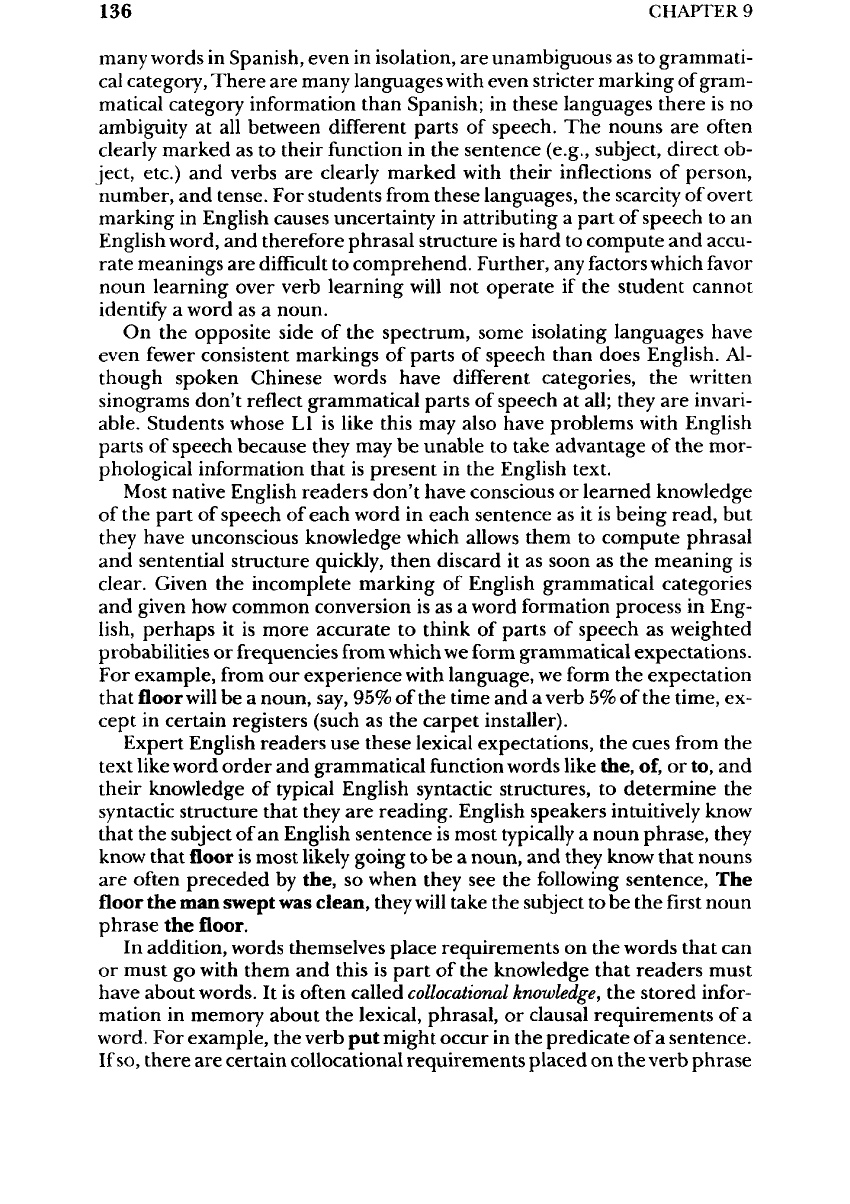
136
CHAPTER
9
many
words
in
Spanish, even
in
isolation,
are
unambiguous
as to
grammati-
cal
category,
There
are
many languages
with
even stricter marking
of
gram-
matical
category information than Spanish;
in
these languages there
is no
ambiguity
at all
between
different
parts
of
speech.
The
nouns
are
often
clearly
marked
as to
their function
in the
sentence (e.g., subject, direct
ob-
ject, etc.)
and
verbs
are
clearly marked
with
their inflections
of
person,
number,
and
tense.
For
students from
these
languages,
the
scarcity
of
overt
marking
in
English causes uncertainty
in
attributing
a
part
of
speech
to an
English
word,
and
therefore phrasal structure
is
hard
to
compute
and
accu-
rate meanings
are
difficult
to
comprehend. Further,
any
factors which
favor
noun learning over verb learning
will
not
operate
if the
student cannot
identify
a
word
as a
noun.
On the
opposite side
of the
spectrum, some isolating languages have
even fewer consistent markings
of
parts
of
speech than does English.
Al-
though spoken Chinese words have
different
categories,
the
written
sinograms don't reflect grammatical parts
of
speech
at
all; they
are
invari-
able. Students whose
LI
is
like this
may
also have problems with English
parts
of
speech because they
may be
unable
to
take advantage
of the
mor-
phological information that
is
present
in the
English text.
Most
native English
readers
don't have conscious
or
learned knowledge
of
the
part
of
speech
of
each word
in
each sentence
as it is
being read,
but
they
have unconscious knowledge which
allows
them
to
compute phrasal
and
sentential structure quickly, then discard
it as
soon
as the
meaning
is
clear. Given
the
incomplete marking
of
English grammatical categories
and
given
how
common conversion
is as a
word formation process
in
Eng-
lish,
perhaps
it is
more accurate
to
think
of
parts
of
speech
as
weighted
probabilities
or
frequencies from which
we
form grammatical expectations.
For
example,
from
our
experience
with
language,
we
form
the
expectation
that
floor
will
be a
noun, say,
95% of the
time
and a
verb
5% of the
time,
ex-
cept
in
certain registers (such
as the
carpet installer).
Expert English readers
use
these lexical expectations,
the
cues
from
the
text like word
order
and
grammatical
function
words like the,
of, or to, and
their knowledge
of
typical English syntactic structures,
to
determine
the
syntactic
structure that they
are
reading. English speakers intuitively know
that
the
subject
of an
English sentence
is
most typically
a
noun
phrase,
they
know
that
floor is
most likely going
to be a
noun,
and
they know that nouns
are
often
preceded
by
the,
so
when they
see the
following sentence,
The
floor the man
swept
was
clean, they
will
take
the
subject
to be the
first
noun
phrase
the floor.
In
addition, words themselves place requirements
on the
words that
can
or
must
go
with them
and
this
is
part
of the
knowledge that
readers
must
have
about words.
It is
often called
collocational
knowledge,
the
stored infor-
mation
in
memory about
the
lexical, phrasal,
or
clausal requirements
of a
word.
For
example,
the
verb
put
might occur
in the
predicate
of a
sentence.
If
so,
there
are
certain collocational requirements placed
on the
verb phrase
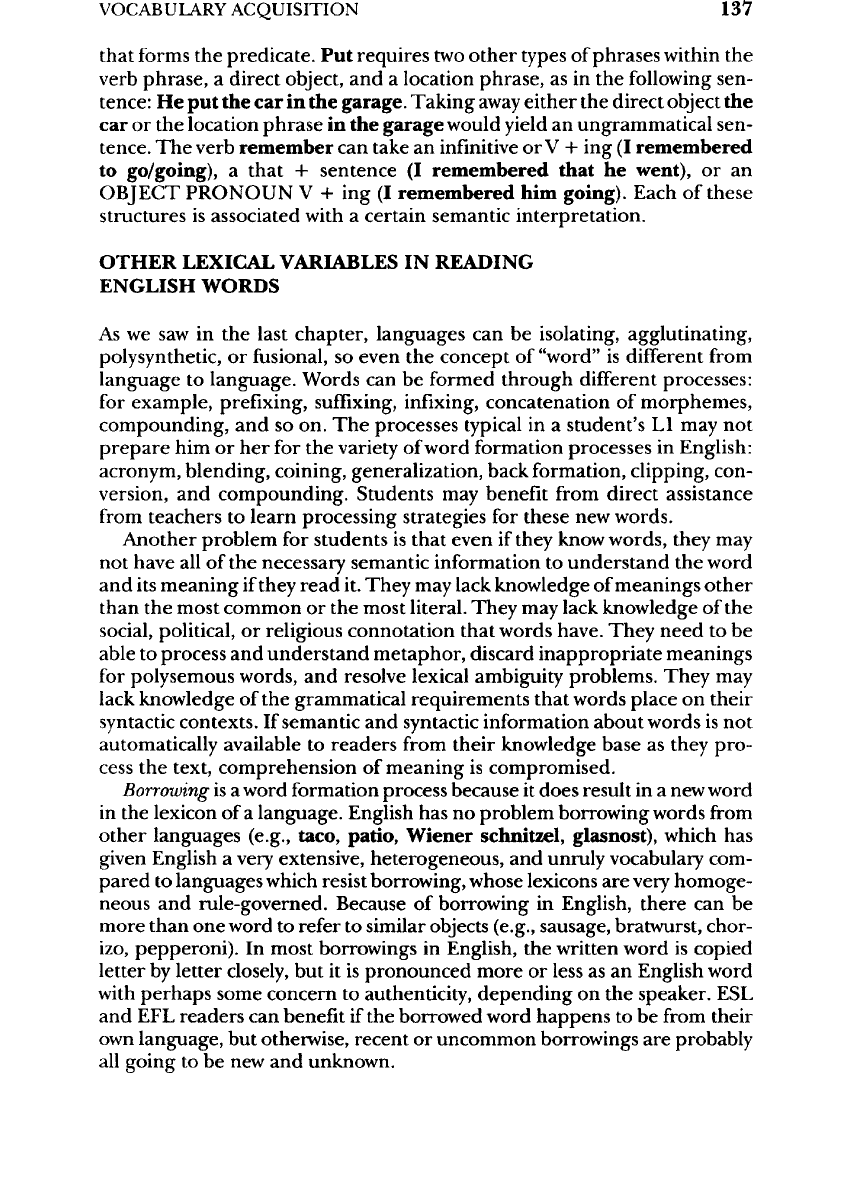
VOCABULARY
ACQUISITION
137
that
forms
the
predicate.
Put
requires
two
other types
of
phrases
within
the
verb
phrase,
a
direct object,
and a
location phrase,
as in the
following
sen-
tence:
He put the car in the
garage. Taking
away
either
the
direct object
the
car or the
location phrase
in the
garage would yield
an
ungrammatical
sen-
tence.
The
verb remember
can
take
an
infinitive
or V + ing (I
remembered
to
go/going),
a
that
+
sentence
(I
remembered that
he
went),
or an
OBJECT PRONOUN
V + ing (I
remembered
him
going). Each
of
these
structures
is
associated
with
a
certain semantic interpretation.
OTHER
LEXICAL
VARIABLES
IN
READING
ENGLISH
WORDS
As
we saw in the
last chapter, languages
can be
isolating, agglutinating,
polysynthetic,
or
fusional,
so
even
the
concept
of
"word"
is
different
from
language
to
language. Words
can be
formed through
different
processes:
for
example, prefixing,
suffixing,
infixing,
concatenation
of
morphemes,
compounding,
and so on. The
processes typical
in a
student's
LI
may not
prepare
him or her for the
variety
of
word formation processes
in
English:
acronym,
blending, coining, generalization, back formation, clipping, con-
version,
and
compounding. Students
may
benefit
from
direct assistance
from
teachers
to
learn processing strategies
for
these
new
words.
Another problem
for
students
is
that even
if
they know words, they
may
not
have
all of the
necessary semantic information
to
understand
the
word
and its
meaning
if
they read
it.
They
may
lack knowledge
of
meanings
other
than
the
most common
or the
most literal. They
may
lack knowledge
of the
social,
political,
or
religious connotation that words have. They need
to be
able
to
process
and
understand metaphor, discard inappropriate meanings
for
polysemous words,
and
resolve lexical ambiguity problems. They
may
lack
knowledge
of the
grammatical requirements that words place
on
their
syntactic
contexts.
If
semantic
and
syntactic information about words
is not
automatically
available
to
readers
from
their knowledge base
as
they pro-
cess
the
text, comprehension
of
meaning
is
compromised.
Borrowing
is a
word formation process because
it
does result
in a new
word
in
the
lexicon
of a
language. English
has no
problem borrowing words
from
other languages (e.g.,
taco,
patio, Wiener schnitzel, glasnost), which
has
given
English
a
very
extensive, heterogeneous,
and
unruly vocabulary com-
pared
to
languages which resist borrowing, whose lexicons
are
very
homoge-
neous
and
rule-governed. Because
of
borrowing
in
English,
there
can be
more than
one
word
to
refer
to
similar objects (e.g., sausage,
bratwurst,
chor-
izo,
pepperoni).
In
most borrowings
in
English,
the
written word
is
copied
letter
by
letter closely,
but it is
pronounced more
or
less
as an
English word
with
perhaps some concern
to
authenticity, depending
on the
speaker.
ESL
and EFL
readers
can
benefit
if the
borrowed word happens
to be
from
their
own
language,
but
otherwise, recent
or
uncommon borrowings
are
probably
all
going
to be new and
unknown.
